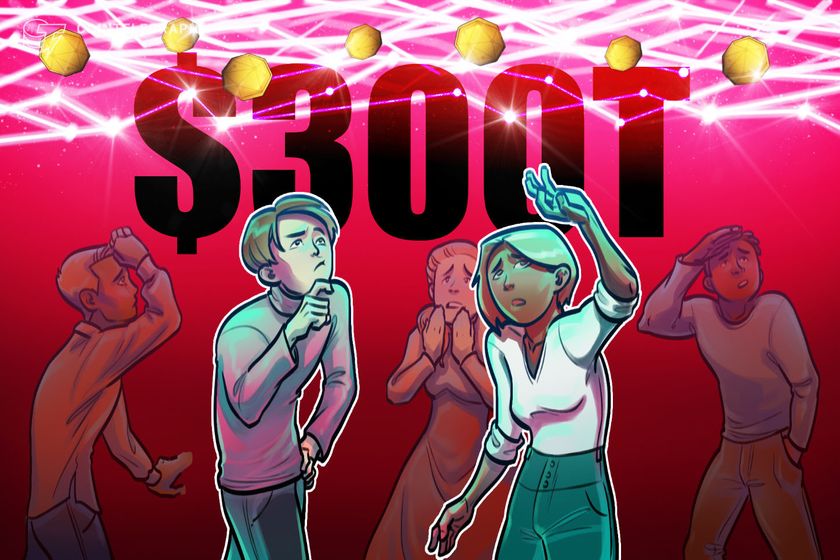Fat finger errors happen all the time, especially in traditional banking. The difference is that blockchain makes it transparent and immediately identifiable. Paxos’ accidental minting of $300 trillion PYUSD on Wednesday, while undoubtedly concerning, serves as a case study as to why blockchain could shine in traditional banking. On Wednesday, Paxos mistakenly minted $300 trillion worth of the PayPal USD (PYUSD) stablecoin, describing it as an “internal technical error.” What’s important, however, is that the blockchain allowed its mistake to be quickly identified and corrected.Read more Fat finger errors happen all the time, especially in traditional banking. The difference is that blockchain makes it transparent and immediately identifiable. Paxos’ accidental minting of $300 trillion PYUSD on Wednesday, while undoubtedly concerning, serves as a case study as to why blockchain could shine in traditional banking. On Wednesday, Paxos mistakenly minted $300 trillion worth of the PayPal USD (PYUSD) stablecoin, describing it as an “internal technical error.” What’s important, however, is that the blockchain allowed its mistake to be quickly identified and corrected.Read more
Banks fumble TXs too; at least Paxos’ $300T error was transparent
2025/10/16 12:47

Fat finger errors happen all the time, especially in traditional banking. The difference is that blockchain makes it transparent and immediately identifiable.
Paxos’ accidental minting of $300 trillion PYUSD on Wednesday, while undoubtedly concerning, serves as a case study as to why blockchain could shine in traditional banking.
On Wednesday, Paxos mistakenly minted $300 trillion worth of the PayPal USD (PYUSD) stablecoin, describing it as an “internal technical error.”
What’s important, however, is that the blockchain allowed its mistake to be quickly identified and corrected.
Read more
Disclaimer: The articles reposted on this site are sourced from public platforms and are provided for informational purposes only. They do not necessarily reflect the views of MEXC. All rights remain with the original authors. If you believe any content infringes on third-party rights, please contact [email protected] for removal. MEXC makes no guarantees regarding the accuracy, completeness, or timeliness of the content and is not responsible for any actions taken based on the information provided. The content does not constitute financial, legal, or other professional advice, nor should it be considered a recommendation or endorsement by MEXC.
Share Insights
You May Also Like

Ripple Seals $1.25B Deal to Acquire Hidden Road — Big Move in Crypto
Ripple Advances Its Institutional Footprint with Major Prime Brokerage Acquisition Ripple continues to expand its influence in the financial technology space, announcing the completion of its acquisition of non-bank prime broker Hidden Road. Rebranded as Ripple Prime, this strategic move marks one of its most substantial investments, positioning the company as a leader in multi-asset [...]
Share
2025/10/25 14:27

Cashing In On University Patents Means Giving Up On Our Innovation Future
The post Cashing In On University Patents Means Giving Up On Our Innovation Future appeared on BitcoinEthereumNews.com. “It’s a raid on American innovation that would deliver pennies to the Treasury while kneecapping the very engine of our economic and medical progress,” writes Pipes. Getty Images Washington is addicted to taxing success. Now, Commerce Secretary Howard Lutnick is floating a plan to skim half the patent earnings from inventions developed at universities with federal funding. It’s being sold as a way to shore up programs like Social Security. In reality, it’s a raid on American innovation that would deliver pennies to the Treasury while kneecapping the very engine of our economic and medical progress. Yes, taxpayer dollars support early-stage research. But the real payoff comes later—in the jobs created, cures discovered, and industries launched when universities and private industry turn those discoveries into real products. By comparison, the sums at stake in patent licensing are trivial. Universities collectively earn only about $3.6 billion annually in patent income—less than the federal government spends on Social Security in a single day. Even confiscating half would barely register against a $6 trillion federal budget. And yet the damage from such a policy would be anything but trivial. The true return on taxpayer investment isn’t in licensing checks sent to Washington, but in the downstream economic activity that federally supported research unleashes. Thanks to the bipartisan Bayh-Dole Act of 1980, universities and private industry have powerful incentives to translate early-stage discoveries into real-world products. Before Bayh-Dole, the government hoarded patents from federally funded research, and fewer than 5% were ever licensed. Once universities could own and license their own inventions, innovation exploded. The result has been one of the best returns on investment in government history. Since 1996, university research has added nearly $2 trillion to U.S. industrial output, supported 6.5 million jobs, and launched more than 19,000 startups. Those companies pay…
Share
2025/09/18 03:26

Bitdeer mined 123.4 BTC this week, bringing its total Bitcoin holdings to 2,180.2.
PANews reported on October 25th that Bitcoin mining company Bitdeer tweeted that its Bitcoin holdings had increased to 2,180.2 as of October 24th (net holdings, excluding customer deposits). Furthermore, Bitcoin mining output for the week was 123.4 BTC, but 70 BTC were sold during the same period, for a net increase of 53.4 BTC.
Share
2025/10/25 13:47